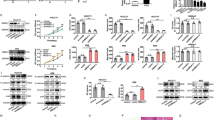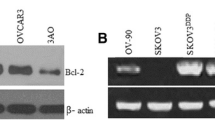Abstract
In the individual application of adriamycin, mitomycin, vindesine and their combined application with tamoxifen for the pre-treatment of the human cholangiocarcinoma cell line QBC939, QBC939 was determined by MTT assay to investigate the inhibitive effect and its initial mechanism of TAM on cell growth. Growth cycle and apoptosis of each group were determined by flow cytometry. Concentration of ADM in QBC939 was detected by flow cytometry. The levels of their P-glycoprotein were detected by immunohistochemistry. The mRNA and protein levels of apoptotic-associated genes Bcl-2 and Bax were determined by western blot and real-time PCR. The inhibitive rates of adriamycin, mitomycin, vindesine to QBC939 and the apoptosis rates of QBC939 were enhanced after the pre-treatment of tamoxifen. Influence of tamoxifen in their growth cycle was not so obvious except vindesine group because of the increasing cell numbers of G 2/M phase in which cells may be blocked. The contents of adriamycin in cells rose after the pre-treatment of tamoxifen. Expression level of the multi-drug resistant protein on cell surface was shown as (+). Furthermore, real-time PCR and Western blot analysis revealed an upregulation of Bcl-2 and a downregulation of Bax in QBC939 after the pre-treatment of tamoxifen. Therefore, tamoxifen may have the ability to enhance the relative sensitivity of QBC939 to chemotherapeutics.







Similar content being viewed by others
References
Groen PC, Gores GJ, LaRusso NF, Gunderson LL, Nagorney DM (1999) Biliary tract cancers. N Engl J Med 18:1368–1378
Lazaridis KN, Gores GJ (2005) Cholangiocarcinoma. Gastroenterology 128:1655–1667
Hur H, Park IY, Sung GY et al (2009) Intrahepatic cholangiocarcinoma associated with intrahepatic duct stones. Asian J Surg 1:7–12
Jarnagin WR, Fong Y, DeMatteo RP et al (2001) Staging, resectability, and outcome in 225 patients with hilar cholangiocarcinoma. Ann Surg 234(4):507–517 (discussion 517–519)
Todoroki T, Kawamoto T, Koike N et al (2001) Treatment strategy for patients with middle and lower third bile duct cancer. Br J Surg 88(3):364–370
Sagawa N, Kondo S, Morikawa T et al (2005) Effectiveness of radiation therapy after surgery for hilar cholangiocarcinoma. Surg Today 35(7):548–552
Pitt HA, Nakeeb A, Abrams RA et al (1995) Perihilar cholangiocarcinoma postoperative radiotherapy does not improve survival. Ann Surg 221(6):788–797 (discussion 797–798)
Shinchi H, Takao S, Nishida H et al (2000) Length and quality of survival following external beam radiotherapy combined with expandable metallic stent for unresectable hilar cholangiocarcinoma. J Surg Oncol 75(2):89–94
Bowling TE, Galbraith SM, Hatfield AR et al (1996) A retrospective comparison of endoscopic stenting alone with stenting and radiotherapy in non-resectable cholangiocarcinoma. Gut 39(6):852–855
Sirica AE (2005) Cholangiocarcinoma: molecular targeting strategies for chemoprevention and therapy. Hepatology 41:5–15
Kaassis M, Boyer J, Dumas R et al (2003) Plastic or metal stents for malignant stricture of the common bile duct? Results of a randomized prospective study. Gastrointest Endosc 57(2):178–182
Chang WH, Kortan P, Haber GB (1998) Outcome in patients with bifurcation tumors who undergo unilateral versus bilateral hepatic duct drainage. Gastrointest Endosc 47(5):354–362
Prat F, Chapat O, Ducot B et al (1998) Predictive factors for survival of patients with inoperable malignant distal biliary strictures: a practical management guideline. Gut 42(1):76–80
Figueras J, Llado L, Valls C et al (2000) Changing strategies in diagnosis and management of hilar cholangiocarcinoma. Liver Transp l6(6):786–794
Takada T, Amano H, Yasuda H et al (2002) Is postoperative adjuvant chemotherapy useful for gallbladder carcinoma? A phase III multicenter prospective randomized controlled trial in patients with resected pancreaticobiliary carcinoma. Cancer 95(8):1685–1695
Todoroki T (2000) Chemotherapy for bile duct carcinoma in the light of adjuvant chemotherapy to surgery. Hepatogastroenterology 47(33):644–649
Rao S, Cunningham D, Hawkins RE et al (2005) Phase III study of 5FU, etoposide and leucovorin (FELV) compared to epirubicin, cisplatin and 5FU (ECF) in previously untreated patients with advanced biliary cancer. Br J Cancer 92(9):1650–1654
Glimelius B, Hoffman K, Sjödén PO et al (1996) Chemotherapy improves survival and quality of life in advanced pancreatic and biliary cancer. Ann Onco l7(6):593–600
Shaib Y, El-Serag HB (2004) The epidemiology of cholangiocarcinoma. Semin Liver Dis 24:115–125
Han P, Kang JH, Li HL et al (2009) Antiproliferation and apoptosis induced by tamoxifen in human bile duct carcinoma QBC939 cells via upregulated p53 expression. Biochem Biophys Res Commun 385(2):251–256
Tobias JS (2004) Endocrine approaches for the treatment of early and advanced breast cancer in postmenopausal women. Int J Biochem, Cell Biol 36:2112–2119
Grainger J, Metcalfe JC (1996) Tamoxifen: teaching an old drug new tricks? Nat Med 2:381–385
Mandlekar S, Kong AN (2001) Mechanisms of tamoxifen-induced apoptosis. Apoptosis 6:469–477
Carmichael J, DeGraff WG, Gazdar AF et al (1987) Evaluation of a tetrazolium-based semiautomated colorimetric assay: assessment of chemosensitivity testing. Cancer Res 47:936–942
Kerb R, Hoffmeyer S, Brinkmann U (2001) ABC drug tansporters: hereditary polymorphisms and pharmacological impact in MDR1, MRP1 and MRP2. Pharmacogenomics 1:51–64
Hooiveld GJ, Van Montfoort JE, Meijer DK et al (2001) Function and regulation of ATP-binding cassette transport proteins involved in hepatobiliary transport [J]. Eur J Pharm Sci 4:525–534
Ferguson PJ, Brisson AR, Koropatnick J et al (2009) Enhancement of cytotoxicity of natural product drugs against multidrug resistant variant cell lines of human head and neck squamous cell carcinoma and breast carcinoma by tesmilifene. Cancer Lett 2:279–289
Andersen J, Kamby C, Ejlertsen B et al (2008) Tamoxifen for one year versus two years versus 6 months of Tamoxifen and 6 months of megestrol acetate: a randomized comparison in postmenopausal patients with high-risk breast cancer (DBCG 89C). Acta Onco l4:718–724
Singh MN, Martin-Hirsch PL, Martin FL (2008) The multiple applications of tamoxifen: an example pointing to SERM modulation being the aspirin of the 21st century. Med Sci Monit 9:RA144–RA148
Incles CM, Schultes CM, Kelland LR et al (2003) Acquired cellular resistance to flavop iridol in a human colon carcinoma cell line involves up-regulation of the telomerase catalytic subunit and telomere elongation. Sensitivity of resistant cells to combination treatment with a telomerase inhibitor 1 [J]. Mol Pharmacol 5:1101–1108
Andrew DG, Giles R (2005) Mathematical modeling of magnetically targeted drug delivery. J Magn Magn Mater 5:455–463
Yoshino T, Hirabe H, Takahashi M et al (2008) Magnetic cell separation using nano-sized bacterial magnetic particles with reconstructed magnetosome membrane. Biotechnol Bioeng 101(3):470–477
Iain B, Kawan S, Sarahl M (2004) Reduced expression of p27 is a novel mechanism of docetaxel resistance in breast cancer cells [J]. Breast Cancer Res 56:601–607
Ghayad SE, Bieche I, Vendrell JA et al (2008) mTOR inhibition reverses acquired endocrine therapy resistance of breast cancer cells at the cell proliferation and gene-expression levels. Cancer Sci 10:1992–2003
Acknowledgments
The authors thank Shanghai Jiao Tong University Affiliated Sixth People’s Hospital for technical assistance during this study. This work was financially supported by National Natural Science Foundation of China (No. 30672044), and the National Basic Research Program of China (No. 2008CB517403).
Author information
Authors and Affiliations
Corresponding author
Rights and permissions
About this article
Cite this article
Liu, ZH., He, YP. & Qin, H. The growth-inhibition effect of tamoxifen in the combination chemotherapeutics on the human cholangiocarcinoma cell line QBC939. Mol Biol Rep 37, 2693–2701 (2010). https://doi.org/10.1007/s11033-009-9801-2
Received:
Accepted:
Published:
Issue Date:
DOI: https://doi.org/10.1007/s11033-009-9801-2




